Whale Watching Tuesday, August 05, 2008
Blue Whale Adventure
The water was calm and glassy as we left the harbor. It also seemed oddly empty. Besides the half a dozen California Sea Lions on the buoy, there were no bottlenose dolphins near the sand bar as have often sent us off on our deep channel voyages. So we pressed on, heading straight towards Santa Cruz island and the famed Painted Cave. Sure enough about 30 minutes into the trip with the continued glass calm waters were some common dolphins. It didn’t look like much of a group, perhaps 20 dolphins that appeared to be feeding. But as soon as we stopped, it became apparent that they were only a small part of a larger pod feeding in that area. About 300 or so, surfacing, milling about, diving and splashing. There were a few that we could spot zipping around near the boat, chasing fish up and out of the water on several occasions.
After delighting and interacting with them for at least a half an hour or literally running circles around them, we pushed on towards Santa Cruz Island. As we could see the land off in the distance, I was talking to Bernardo Alps and we both turned to see a Minke Whale surfacing nearby. In my experience with Minkes (and one in nearly the same location last year) I figured that’d probably be the only look we’d get. Instead this Minke surfaced again and again, in regular succession. Then turned back towards our boat, coming about thirty feet from us and turned upside down, pushed with its strong flukes and came up and out of the water for a moment. It looked a lot like those common dolphins chasing down bait fish earlier - only instead of being six feet long this one was about sixteen. (Still a very small specimen.) We got a good look at his white belly, striped flipper and even the narrow and pointy chin as he lifted it out when surfacing. After a few more cycles another Minke surfaced nearby, much larger, and possibly the mother of our unusually exuberant one.
We pushed on to Santa Cruz Island to have a look at Painted Cave. It’s an interesting opportunity to look at the sea birds that skim the waters near the rocks and perch there. Part of the reason for the early look at Painted Cave was the hope that the fog would burn off out in the Channel. Alas, little luck with that, so we pushed on, into the fog to see what we could see. After putting a photographer on a research vessel from the University of Oregon, they told us of a blue whale in the area. Even though visibility was poor, probably not more than fifty feet, Captain Mat slowed the boat and ran in wide circles. Eventually someone heard one of the blows and there it was a huge blue whale. It was strong and much meatier/fatter than ones I’ve seen in past years.
Unfortunately I had a bout of motion sickness about the time we spotted the first whale which lasted for pretty much the whole afternoon. This leads to a lot of internal admonishments about bringing medicine or maybe just not going on the full day trips in the future. As the wind picked up though and the air cleared I felt much better and enjoyed our last few sightings. (Though I took fewer pictures towards the end.) What’s become clear is that the Santa Barbara Channel has become host to a vigorous group of Blue Whales and the prospect of seeing other creatures like Minke and Humpback (none this time) and of course the many species of dolphins makes this a world class destination. Just 90 minutes from my house. Now I just need to conquer sea-sickness. POSTED BY Cybele AT 7:32 am Whale Watching • Monday, July 30, 2007
Blue Whales in Santa BarbaraThis was a fabulous trip for several reasons. We had lots of company (The Man’s brother, nephew and his girlfriend from Florida plus two friends from LA joined us). And of course the weather cooperated and we got to see some whales! First thing we saw were several small pods of Long Beaked Common Dolphins. What fun, they came along and swam with the boat for a while. The morning was rather gray and I was hoping it would burn off quickly. It was certainly not as dim as the previous trip, but still, as we got out to the prime Blue Whale zone, visibility at times wasn’t more than 500 yards. We did come upon a pair of blue whales though and this time in addition to taking photos, I tried for a little video (mostly because I think that’s the only way you can get the scale of these creatures).
Later Captain Mat excited threw on the boat brakes to have a look at this. It’s a Basking Shark. The sharks themselves are probably rather common, but seeing them off of Santa Barbara and close to the surface like this is quite rare. The video isn’t that impressive, really, the distance between the dorsal fin and the waggling tail fin is probably 6-8 feet, so the shark is probably only about 12-16 feet. (They can grow to be 30 feet.)
Most importantly we saw the blue whales so clearly, following along with the first pair for quite a while. I was very, very tired when we were done, but of course I want to do it again. No new species to add to my list of cetaceans, but the basking shark was certainly special. POSTED BY Cybele AT 2:57 pm Whale Watching • Sunday, May 27, 2007
Santa Barbara for Whale Watching
We tried something new, kind of geotagging the adventure. The photos aren’t precisely located on this map, but I don’t suppose anyone can argue with me since they’re within about a half a mile or so. (Maybe ... I have no clue.) You can see my whole set of photos grouped by where they were shot. Here’s a brief chronlogy of our adventure. 4:30 AM - Wake, shower and make lunch. I was fabulously tired and about five miles from shore we finally got some sun. But at least there wasn’t much wind or waves. Good trip. Good trip. I want to do it again later this summer. We got good looks at about 12 whales and saw about 18 total (if you count distant blows). I can tick two species off my list - Dall’s Porpoise and Minke Whale (though I wouldn’t mind getting a better view). See all photos on Flickr in my set and of course check out The Man’s. POSTED BY Cybele AT 3:02 pm Whale Watching • Monday, April 09, 2007
Sperm Whales Run DeepI have a Google News alert set up for Whale (and one for Dolphins, but I get a lot of sports news on that one). Today’s report featured news that there was a Sperm Whale that washed ashore in Santa Barbara. Here’s my favorite quote:
Yeah. So anyone else see anything wrong with the first sentence? It’s not like there are a lot of different kinds of Sperm Whales out there, like dolphins. I’d say the second sentence is kind of funny, too. Yes, it’s very unusual to find whales up on the beach. Except, you know, when they beach themselves or wash ashore. POSTED BY Cybele AT 12:26 pm Whale Watching • Wednesday, January 03, 2007
Watery Word ChoicesLast night at whalewatching class was a presentation on “Threats to Cetaceans.” The big threats, as you can imagine are whaling, pollution and loss of habitat (because of climate change or loss of habitat). But it got me to thinking about whaling. Why do we call it whaling? When you go out duck hunting, you don’t go ducking (well if you go with Dick Cheney you might want to). Of course when you go out fish hunting we do call it fishing. Why are the words for hunting things in the water like that? POSTED BY Cybele AT 9:47 am Whale Watching • Sunday, February 19, 2006
Clear, Cold and Dolphiny(cross posted on blogging.la) It is so incredibly clear today, I’m not sure I’ve ever seen it like this before. I went out on the Voyager this afternoon (I admit it was a bit chilly on the water) and was surprised at the intense detail and visibility. Today’s adventure started out a little less promising than our others. No whales were sighted by the morning boat, but they did have a super-pod of dolphins. In the afternoon the wind was picking up so there were some small whitecaps through the swells were only 2-4 feet. The exceptional visibility played tricks on us, as we spotted what might have been some dolphin heading across Santa Monica Bay towards Pt. Dume, but as we turned out and approached, they disappeared completely. No matter, it was early and we turned south towards Pt. Vicente, stopping briefly at buoy PV10 to look at the sea lions. Continuing south it was nearly 90 minutes into the trip when we spotted a huge bunch of birds off towards the horizon. Captain Gary mentioned that he saw dolphin below the birds and there was a lot of talk in the wheel house about whether it was birds or dolphins making the spashes. Finally the Captain turned the Voyager out towards Catalina to determine what it was. It was pretty clear after only a few minutes that it was a large pod of dolphins. Another ten minutes or so and we were traveling along at about six miles an hour with a huge pod of about 800 common dolphin pointed towards Pt. Dume. They were feeding on the way, probably some small bait fish (I never caught site of them). We were in the middle of the group, many rode the pressure wake of the bow, others followed alongside the boat and still other surfed in the wake of the Voyager. We followed along with them for 30 minutes, and luckily they were headed in the same direction we needed to go. Honestly, I could just go out and watch dolphins all day. But we were already running kind of late as the Captain angled our journey to maximize our time with the dolphins. As luck would have it, we did find one Gray Whale on our way back into Santa Monica Bay, just opposite the wreck of the Dominator and we delayed our return to the slip for another fifteen minutes as we tried to get a good view of him (he was heading west). Even without the sea life, it was an exceptional day for the views. From off San Vicente we could see Angel’s Gate, the full length of Santa Catalina all the way to the Hollywood sign and the occasional peek of the snowcapped mountains through the clouds. Read more of my whale watch adventures on blogging.la: 2-12-2006 & 12-26-2005, 7-21-2005, 5-15-2005, 1-30-2005 & 1-17-2005 and of course all the whaley goodness right here on fast fiction. POSTED BY Cybele AT 11:25 pm Whale Watching • Sunday, February 12, 2006
The Day of the DolphinI’ve been out on a few whale watching tours now but I have to say that the best ones always involve dolphins. Today’s trip out of Redondo Sport Fishing on the Voyager with Captain Gary involved a lot of dolphins. The weather was absolutely amazing today. Excellent visibility, warm weather, calm winds and clear water. You really couldn’t ask for anything more. As we got out into the bay I spotted a huge pod of dolphins miles off to the north of us heading towards Pt. Dume. As tempting as it was to go towards them, they were moving away from us, and it didn’t seem that we’d be able to catch up with them. But something happened out there, they must have come across some fertile feeding grouds because they stopped and a huge swarm of birds were building up over the pod. Captain Gary decided we’d turn towards them and take our chances that they’d stay put. I was so excited! The conditions were ideal for good photos of the dolphins in the water. We didn’t spend long with the long-beaked common dolphin pod, but that’s okay. It was an amazing half hour. I took about 250 pictures. Then we headed off towards some Pacific Gray Whales that were spotted back near Torrance Beach. It was a rather odd sighting. The whales were in a bad position as there was a huge amount of traffic in the bay, especially as they were hugging the coast within the bay. There were plenty of times where they changed their direction or breathing patterns because of the boats nearby. As we rounded the point the traffic seemed a bit better and they settled into a better pattern, however, it took them closer to shore and we didn’t get as good a look. I’m not going to get to go out again in the next few weeks, so to end my February schedule with this trip was pretty awesome. What’s more, the passengers on the trip seemed equally thrilled with their experience. POSTED BY Cybele AT 10:12 pm Whale Watching • Friday, January 20, 2006
Whale Watch - Spirit CruisesToday was my first voyage on the Pacific Spirit with Captain Tim at Spirit Cruises down at San Pedro’s cute little Ports o’ Call. I’d never been out on this boat before (though I’ve been booked on it before and even boarded the boat on December 30th before the boat was canceled). The weather was stunning today. The air was crystal clear, the water smooth and calm and it was rather warm. Captain Tim took us through the harbor area, pointing out the raft of sea lions near the pier by the fish market and then we made our way out to the open waters, past Angel’s Gate Lighthouse on the San Pedro jetty.
We stayed with the whale for well over thirty minutes, following it south as it made a bee line for Dana Point.
On its last but lackluster dive we turned further out to catch up with some dolphins seen further out. What we thought were common dolphins turned out to be much more. We first came across a small pod of common dolphins (at least eight individuals) that met up with the boat and surfed in our wake. We continued towards the larger group that appeared to be feeding. Those were not common dolphins, instead they were bottlenose dolphins. They were delighted to see the boat and though it was a small group (probably a dozen) at least three joined in a few times to swim in the boat’s bow wake. We had a large number of children on board, and they just scream with delight when the dolphins come up to the boat. A few circles in the area and the captain went off to catch back up with our faithful whale. As we headed towards him we instead ran across another small group of Risso’s dolphins. These were by far the most visible of all the dolphins we saw for the day, moving more slowly and showing more of their heads as they came up to breath and moved around. I suspect there were squid that these dolphins were feeding on. They were definitely staying in the same area, and there were plenty of gulls (but no Pelicans, which don’t eat squid). I was suprised by the number of Heerman’s gulls. I’ve not seen many of them over at Redondo Beach, but there seem to be lots of them out of Ports ‘o Call. I think they’re very pretty gulls, with their bright white heads, red beaks and waxy gray bodies. On our way back to the harbor the Captain stopped at one of the buoys to visit with the sea lions. There were two of them on the buoy , both males, and one of them had a huge growth at the base of his flukes. The little kids kept pointing at it and asking about it. I didn’t know quite what to say, since I didn’t think that sea lions had testicles. I’m going to print out a picture and take it into class, I have a feeling it’s some sort of tumor. It was probably the size of a mango - far too large to be a normal scrotum. I hope it’s not an indication of something dastardly going on in the harbor that may affect the wildlife. The past two trips have had huge varieties of wildlife out on the water, they’re like dream trips where we get to see whales and dolphins. It just makes me so happy that I started doing this whalewatching stuff in the first place. POSTED BY Cybele AT 11:58 pm Whale Watching • Tuesday, January 17, 2006
Monday Trip on VoyagerYesterday was an awesome trip on the Voyager’s afternoon trip from Redondo Beach. It was the kind of trip that I think naturalists dream of. The weather was mild and beautiful. A little chilly, but the waters were calm and the air was brilliantly clear. We set out at 1:30 with a rather full boat with over 50 passengers. I talked with my fellow naturalist, John, and we agreed because of my bum knee that I would take the mic for the whole trip so I didn’t have to deal with trying to navigate around the boat during the ride. It was the first time I’ve done the whole trip as the lead naturalist, the first time I’ve really had to narrate much at all. I felt pretty comfortable about it, and I think part of it was that I’m more familiar with the material and also because Will was along and he’s always such a good audience. I tried to remember some of the biggest comments I’ve gotten, especially the one to “slow down and not talk too much.” About 40 minutes out we passed around Rocky Point and caught sight of at least one whale close by and another a bit further out to sea. Captain John pointed us towards the closest whale and we tailed him for at least five cycles on the surface. He was not a regular whale, he didn’t follow the guide books completely. He would surface, sometimes taking his first breath and briefly snorkeling and taking another quickly after that. He did some wonderful fluking and because of the moderate wind we got some very good views of his flukeprints. He didn’t swim in a straight line, he dodged in and out, possibly because of his proximity to the point and possibly because of the other whale nearby. We never got particularly close to him and he probably preferred it that way. His irregularity made it a little difficult to predict where he’d be and how many breaths he’d take. Of course he didn’t stay down for 7 minutes or more like last week’s whales. After following this lone whale for over 40 minutes our other naturalist, John, called the whalewatch census that pointed out a pod of dolphins a bit further out to sea. We’d seen the glinting of dorsals and a few light blows and some birds and knew they were dolphins, but it was the spotters with their scope that confirmed that it was Risso’s dolphins. I was really excited by this since I’d never seen Risso’s before. Of course I didn’t want to tell Captain John that I really, really, really, really wanted us to go out there to see them. I’m just there to help tell our passengers what we’re seeing. As we got closer to them in our current course I directed the passengers to look for the blows from the dolpins. Luckily John waited for another fluke from our present whale and turned us towards the dolphins. While on our way out there I gave the brief info that I had about the Risso’s which is pretty scant. They’re dolphins, about the size of bottlenose dolphins, 10-13 feet long, but with no real beak. They’re dark grey at birth but as they get older they get scarred and streaked until some are practically white. Their dorsal fins are quite tall and are often mistaken for Orcas, especially at a distance.
Risso’s, as it turns out, are rather aloof dolphins. Unlike the long-beaked and short-beaked common dolphins and bottlenose that I’ve seen before that come right up to the boat and bow-ride, the Risso’s pretty much go about their business. But it’s pretty cool to observe them ignoring us. As far as I could tell, there were well over 20 individuals scattered over a pretty large area about a half a mile wide. They appeared to be feeding and worked in small groups of up to four individuals. They’re known to eat squid and though we saw birds around, they were gulls and I didn’t see any Pelicans, which apparently don’t eat squid.
The Captain powered down the boat and we made several slow circles through the group. With the engine and wind noise gone, all we could really hear were the squeals of the kids on board that were just tickled pink at the dolphins and pointed them out all around the boat and then there were the sounds of the dolphins themselves. They made that poofing sound as they exhaled sharply. If you didn’t see them coming up, you knew where to look just by the sound. The water was wonderfully clear and with the swells we could see the lightest colored Risso’s under the water, darting around in different directions. Sometimes two or three would come to the surface at once, and I even saw two jump partway out of the water. At that point we were two hours into the trip and Captain John parted with the Risso’s and we headed back into Santa Monica Bay. As we passed the Dominator I prepared to wind up the trip and started my little audio presentation about the patches that we sell for the Whalewatch program and there was a loud bunch of hollering from the passengers and they all pointed at three o’clock as we saw at least two whales speeding along, hugging the coast. Whoo! More whales! The Captain pulled around to see them, of course he had to turn out and away from them, lest he get to close. I was hoping it was a mother and calf, as they often hug the inside of the bay like that. But it was possibly better, three or maybe four whales. All coming up in close proximity and the light from the setting sun was just stunning. It was a little tough as we lost them in the glare on the water at one point, but after another cycle Captain John positioned us to catch some really nice flukes from two of the whales. I’m sure we all would have liked to keep following them around the point, but it was time to go back to shore. Captain John pointed us back towards Redondo Beach, we made a short stop at the buoy at the breakwater to peek at the hauled-out sea lions and then we were home again. My pictures for this trip are rather lackluster, I’m afraid, as I was concentrating on creating the experience for the passengers. Not a bad compromise at all! I’m booked to go out again this weekend, a Saturday morning boat from Spirit Cruises at Port-o-Call. That’s a boat what there Captain does the mic talk, so I’ll be able to move around and maybe get some more pictures. Here’s what the whale census had to say:
POSTED BY Cybele AT 10:30 pm Whale Watching • Monday, December 26, 2005
Whale Watch Training!Today was the annual traning trip for the Cabrillo Marine Aquarium’s whale watch docent naturalist program. I was worried that the trip would be canceled for bad weather, after all, we have huge swells hitting our coast from storms far out in the Pacific, but today was remarkably calm. Even though it was raining when I left the house, I called the landing to get confirmation that things were a go. And they were. It was still drizzly as we left on the Voyager but the water was glassy and the swells were rather tame. Unlike a regular whale watching trip, this one was led by no less than a half-dozen naturalists including: Diana McIntyre, Bernardo Alps, Diane Alps, Alisa Schulman-Janiger and John Olguin. Though the whales eluded us (it’s still early in the season) we did find two pods of long-beaked common dolphins. The first was a large one with probably 800 individuals feeding on some herring (or some other small silvery fish) along with a large variety of gulls and pelicans with the occasional sea lion thrown in. But you really just wanna see photos, right? Click for larger versions: Rocky Point as seen from the boat. Common Dolphin pod. Long-beaked common dolphin. Possibly the same long-beaked common dolphin. Palos Verdes Peninsula as seen from Santa Monica Bay A Brown Pelican in breeding plumage. POSTED BY Cybele AT 8:11 pm Whale Watching • Tuesday, December 13, 2005
Narwhal’s tusk explainedMarine Biology Mystery Solved: Function of “Unicorn” Whale’s 8-foot Tooth Discovered After hundreds of years of guessing, Harvard Medical School announced what they believe to be the purpose of the Narwhal’s tusk. The Narwhal is a small toothed whale (member of the Odoncete suborder) that lives in the Arctic and North Atlantic. Males grow to be about 15 feet and weigh about 3,500 pounds and females slightly smaller at 13 feet and a slimmer 2,000 pounds. They are unique in the world of cetaceans in that they have a single tusk, which is a modified tooth grows in corkscrew fashion from their left jaw. Many are up to nine feet long, which means that they may be two thirds as long as their body. Unlike most Acrtic whales, the Narwhal does not migrate south but they do move around in larger groups within the Arctic Ocean from the shores to more open ocean as ice floes cover areas.
This is a totally cool adaptation as far as I’m concerned. Much like a lizard or snake uses their tongue to taste the air, this discovery about the sensory sensitivity of the Narwhal’s tooth must makes their adaption to their habitat all the more admirable. UPDATE: Amazingly detailed article from the NY Times now up! POSTED BY Cybele AT 12:11 pm Whale Watching • Saturday, November 26, 2005
Mysterious Sound Identified as Minke WhalesI was watching some documentary a year or so ago, I think it was about submarines. It was talking about hydrophones and sounds of the deep and mentioned this mysterious boing that no one could identify. They’d been hearing it on hydrophones all over the Pacific since they first started using them. They’d often suspected it was whales, but it’s really hard to prove such things. Well, they finally figured it out. It’s minke whales. Probably male minke whales breeding. Making this boingy noise that reverberates across the whole ocean, to impress the lady whales, or at least tell them where they can find a good mate. You can even hear the sound here and read more about it. POSTED BY Cybele AT 10:47 pm Whale Watching • Wednesday, March 23, 2005
Whale Watch Season Wrap-Up
I’d say I saw about 20 whales this year. No real good up-close looks though. But I guess that will keep me coming back. There was a good article in the LA Times today about gray whales and the threats to their birthing lagoons in Baja. Click on the flash photo gallery - it’s pretty amazing. Voyager II - January 30th out of Redondo Beach - lots of dolphins (my best shots of the year). Whale Watch, um, no Dolphin Watch - my first trip of the year on January 17th. We saw bottlenose dolphins. YaY! Long Beach Sportfishing - Saturday - February 3 (trip was on the 5th) this post features my only real shot of a gray whale I got this year. The Seldom Seen Side of Catalina - I already cross-posted this. The trip was on March 12th and was awesome. The best part of the year absolutely was the dolphins. If they could just take out boats and go looking for dolphins year-round, I’d do that. The Redondo Sportfishing group is going to keep running their whale-watch daily until April 3rd and then they switch to a last weekend of the 9th & 10th. So I might not be done yet! There might be a whale out there ready to show his face and flukes to me in the next few weeks. POSTED BY Cybele AT 9:46 am Whale Watching • Sunday, March 20, 2005
Whale Watch #8
Not much to report, no dolphins. A zig-zagging whale. Lots of wind and choppy water.
POSTED BY Cybele AT 7:54 pm Whale Watching • Sunday, March 13, 2005
The Seldom Seen Side of Catalina Island
We departed from Long Beach along with 500 other people on the Catalina Countess - a huge three story boat that gave us a smooth crossing. It was hazy and overcast but the visibility was pretty good. Shortly after rounding the Palos Verdes Peninsula we spotted two gray whales heading north. We slowed and circled, and caught sight of them once from a distance before we sped off to our destination, the far side of Catalina. During the crossing we had special guest lecturers, including John Olguin giving his amazing recreation of the sounds that whales make (memorized from a record he had), which included the buzzing lawnmower like sounds of pilot whales to the booming thumps of sperm whales to the mournful songs of humpbacks.  As we approached the west end, the first thing evident is that the heavy rains have made Catalina vividly green and lush looking. Even with the heavy clouds, the color was striking. The sun was poking through the cloud wrapped hilltops and illuminating the valleys. Next thing we saw close into shore was a pod of dolphins—make that a megapod—there were thousands, at least two miles long and a half a mile across. The long-beaked common dolphins came out to meet the boat and delighted everyone by riding both in our bow wake and surfing behind in the boat’s wake for about ten minutes. We headed around the western tip and kept a keen eye out for Gray Whales. Though they usually hug the coast on their southern migration, their north migration usually takes advantage of the currents and they skirt along the western side of the island. But we didn’t spot them right away, instead it was a small pod of Bottlenose Dolphins speeding off, probably to feed on nearby squid. Their course paralleled ours for about 10 minutes. Within minutes we spotted some telltale, heart-shaped blows off our starboard and came about to catch up, finding four whales traveling in a loose group. We followed them for close to ten minutes as we watched the megapod of common dolphins we saw from the other side of the island streaming out in a long dark line several miles long towards San Nicolas Island. The same direction we saw the bottlenose heading a half hour earlier. After that burst of activity we settled in to watch the backside of Catalina, with fishing boats anchored close to shore and our geologist guide gave us a wonderful primer on the history of the island and pointed out relevant features. During part of that lecture a Bald Eagle was spotted in the air as it was harassed by some seagulls. Up on the little coves and rocky outcroppings were sea lions and harbor seals hauled out to sun (well, not much sun) themselves in complete seclusion. Far out to sea we saw more blows from other groups of gray whales - too far for us to catch as they were going north and we had to continue south. Rounding the east side of the island brought us back within sight of civilization as we passed the quarry where most of the seawalls in Los Angeles got their rocks. Shortly after rounding the bend we came upon the reverse-osmosis desalination plant for the island residents and then the town of Avalon. Off in the distance were more dolphins throwing themselves out of the water and spinning. The boat had already spent so much time with the whales and other common dolphins that it was time to head back to the dock in Long Beach. As we got closer the clouds cleared and the water turned from turquoise to prussian blue. Getting off the boat, I wanted to relive the day and look at all my photos.   The gray whalewatch season ends in a few weeks, but we’re already making plans to go see the Humpback whales in the Santa Barbara Channel in May and Blue Whales in July. (cross-posted at blogging.la with more photos) POSTED BY Cybele AT 1:41 pm Whale Watching • Sunday, March 06, 2005
Docked
So no boat this week. There are very few opportunities left before the end of the season. Even though the migration (next week begins the “turnaround time” where we’ll see as many southbound whales as northbound) lasts through the end of April, the whale watch boats stop going out (except for charters) at the end of March. Next weekend, The Man and I are going on a naturalist trip that goes around Catalina Island - it’s a whole day boat with the founder of the Cabrillo Marine Aquarium founder, John M. Olguin. I have this image of all the whales and dolphins native to this area just hiding on the other side of the island. That we’d pass around the west side of the island and they’ll just be popping out of the water over there on the mysterious far side of the island. The big question is what shall I do with my now free Sunday morning? So far I’ve done a load of laundry. Later a trip out to Whole Foods and Petco. And of course my afternoon is booked today with a very important activity. I’m crashing the Marathon. Will has already completed the bike tour and started the Marathon about 20 minutes ago. I’ll join him somewhere around mile 20 to boost him with a little turkey jerky and M&Ms. I’ll try to walk with him for a couple of miles. The trick is figuring how to meet up with him - but he’s moblogging as he goes along so we’ll always know where he is. POSTED BY Cybele AT 8:29 am Whale Watching • Sunday, January 30, 2005
Whale Watch #2
This morning I was booked on a whale watch boat out of Redondo Beach (Redondo Sportfishing). The boat is the Voyager, the same one I went out on Monday the 17th. This was a morning trip, so the light is different and I was a little worried that it would be cold out on the water. The air was still and the water calm (though the swells were still about three feet) and the water was spectactularly clear. The landing didn’t send out any boats yesterday, as high winds and swells kept the whale watchers landlocked.
Today was vastly different than last time, mostly because there were three other naturalists on board. The fellow who was the leader was fabulous. He had a wonderful sense of timing, giving basic information to fill the time and then giving out relevant information when we were looking at the actual creatures. In addition to the mentor naturalists were two others. One was a woman who had huge numbers of patches and pins on her jacket, I think going back at least ten years. She had a bag with all sorts of stuff, including patches and pins that she sold on behalf of the organization and reference sheets to show the passengers. I love the trips. I enjoy hanging out at the railing and talking to the passengers about what’s right in front of them (or maybe their camera or other travels). I still haven’t taken the microphone though. I’m not sure what’s holding me back. It’s not like I don’t know the material. I’m not afraid of speaking in front of groups. But maybe I just enjoy being down in the trenches. Well, how am I supposed to know that I prefer that until I try the microphone? Okay, next time! Promise. POSTED BY Cybele AT 8:04 pm Whale Watching • Wednesday, January 19, 2005
Drat!
The whale watch program has only two of three launches going out right now, and of course some very excited rookie whale watch naturalists. I was a little late getting to sign up and didn’t get a boat for this weekend. I did end up with the last rookie spot available for a boat the following weekend (Sunday, January 30th) out of Redondo again. As a consolation, The Man and I are hoping to go up to Pt. Dume this weekend to just look at stuff from the shore. Maybe I’ll get some cool shots from that. My new binoculars are fantastic. They’re Nikons - waterproof and have a full 6 degree field, so I can cover a lot of ground with them. Great optics. I didn’t get to use the new lens over the weekend. The dolphins were plenty close to the boat for getting good shots without it. Though I fully expect to use the telephoto for whales. POSTED BY Cybele AT 10:32 am Whale Watching • Monday, January 17, 2005
Whale Watch (#1 of Many)
The Pacific Gray Whales started their migration a couple of months ago from the Bering and Chukchi Seas and they’re finally making their way past southern California. The first ones were spotted passing Pt. Vicente about a month ago and they’re continuing at a pretty good pace. Today, since the weather was nice, I got my first opportunity to go out and see the whales. The trip started promising. Traveling towards Catalina, we had the sun in front of us, which is great for spotting blows. We left the dock at 1:30 (and returned moments later to pick up a small party that arrived late) and had the good news that the morning trip spotted one whale. On Saturday we saw a Gray Whale from the bluff in Laguna and the census has reported promising numbers.
The little kids (mostly boys aged four to ten) were excited by the dolphins and how close they approached the boat, including quite a few that took to bowriding for a short periods. We spent at least a half an hour among the dolphins, with many swimming below and around the boat, some crossing in front, others far off and uninterested in interacting with us. They didn’t seem to be feeding, just traveling. If they were feeding, there would probably be at least some birds in proximity. After that, we turned back towards shore to do some whale searching. I spent most of my time up on the top deck looking for characteristic blows. However, as we were heading pretty close back to shore (and pretty much defeated) the captain spotted some tell-tale “fluke-prints” which are little disturbances in the surface from either a whale’s flukes as it swims under the water, or usually where the whale broke the surface last. So we slowed and turned and waited. And here’s where it go so vexing. The creature kept making fluke-prints, it was swimming very close to the surface and must have come up for a breath or two (we watched it for almost 30 minutes), but we never saw more than the smallest part of where its blowhole was. There was tail flip, no back knuckles ... nothing. This guy was in stealth mode. Rather than sit on the creature who obviously wasn’t interested in us and of course you’re not supposed to harrass a whale, we moved on. At the end we stopped at one of the buoy’s at the breakwater to look at the sea lions, which always pleases me. I’m looking forward to being a bit more active in my role as docent next trip. Hopefully next weekend. POSTED BY Cybele AT 7:26 pm Whale Watching • 
|
||
ABOUTCATEGORIESCONTACT
ARCHIVES
|
During November it's all about me writing a novel. Sometimes it's about whalewatching. You know, and then there's other stuff.
|

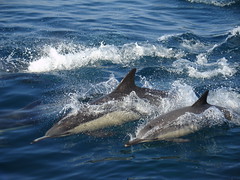
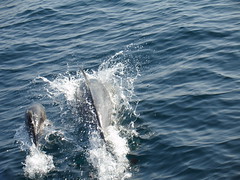
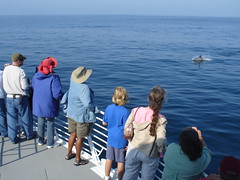






























 As tired as I’ve been from work the past few weeks, I still managed to get my butt up at 4:30 AM yesterday to get to Santa Barbara for an 8 AM cast off at Condor Express. The American Cetacean Society had their first full-day Humpback Whalewatching Trip of the year.
As tired as I’ve been from work the past few weeks, I still managed to get my butt up at 4:30 AM yesterday to get to Santa Barbara for an 8 AM cast off at Condor Express. The American Cetacean Society had their first full-day Humpback Whalewatching Trip of the year. 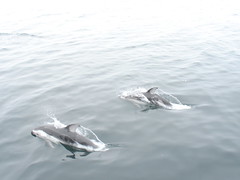
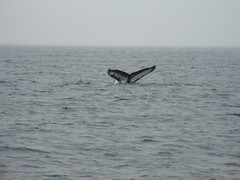
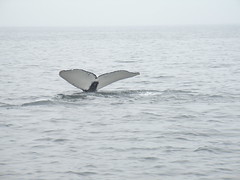
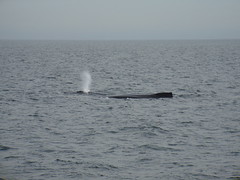



















 I had dreams of adding a tally on the left nav area of my sightings for the year, but I never got around to it.
I had dreams of adding a tally on the left nav area of my sightings for the year, but I never got around to it. 

 About 40 minutes out I noticed a what seemed to be a large pod of dolphins (but they were miles off and I couldn’t be sure) so I pointed it out to the captain. We both debated whether they were feeding pelicans or dolphins and as we got closer it was obvious to both of us that we had a large pod of dolphins (we guessed Common Dolphins at that time). They were heading north and the captain pointed us towards the north to catch up with them. They were not common dolphins at all, but bottlenose dolphins, which I’ve never seen off the coast here (though they’re not, by any means rare). The dolphins were traveling in smaller groups within the large pod, usually three or more, often porpoising in synchronized sequence.
About 40 minutes out I noticed a what seemed to be a large pod of dolphins (but they were miles off and I couldn’t be sure) so I pointed it out to the captain. We both debated whether they were feeding pelicans or dolphins and as we got closer it was obvious to both of us that we had a large pod of dolphins (we guessed Common Dolphins at that time). They were heading north and the captain pointed us towards the north to catch up with them. They were not common dolphins at all, but bottlenose dolphins, which I’ve never seen off the coast here (though they’re not, by any means rare). The dolphins were traveling in smaller groups within the large pod, usually three or more, often porpoising in synchronized sequence.

